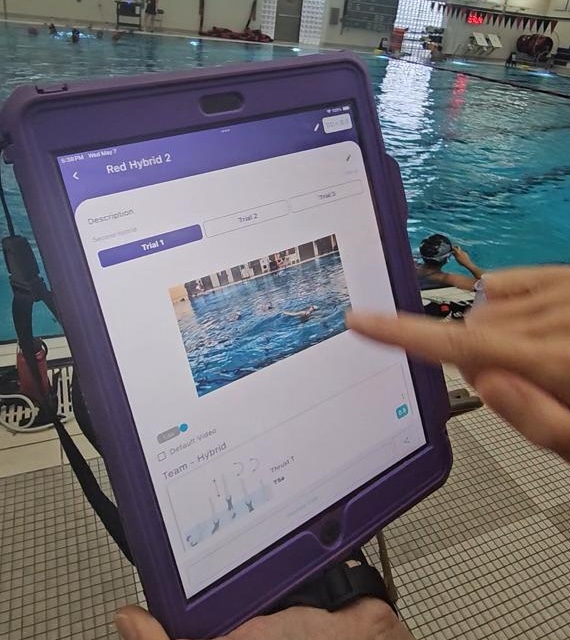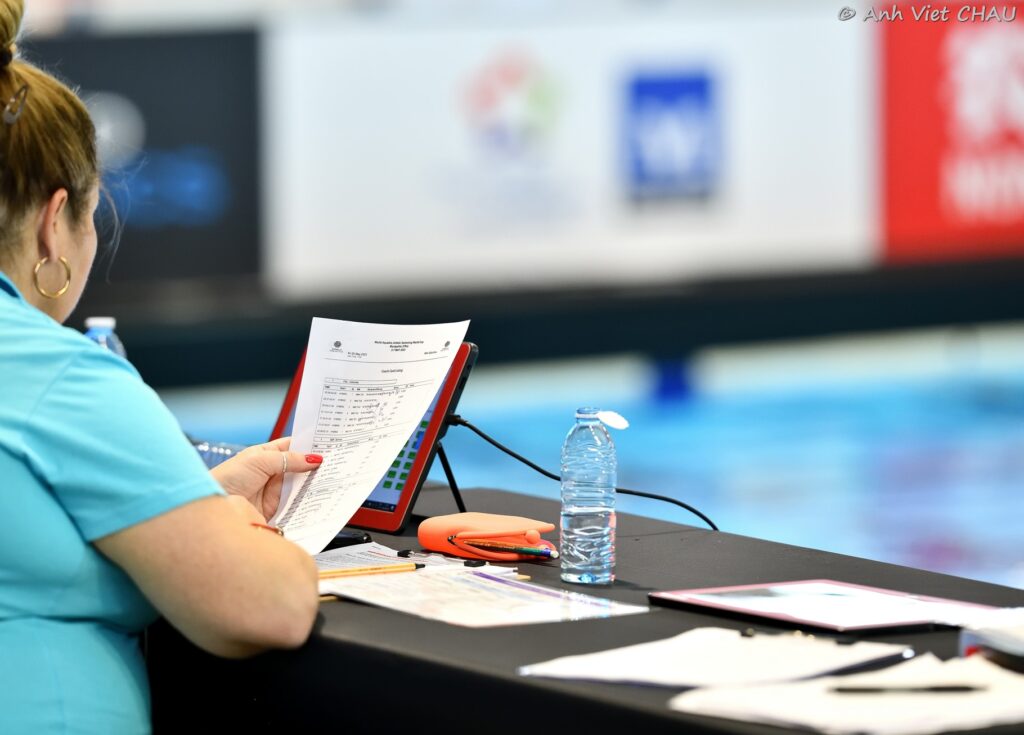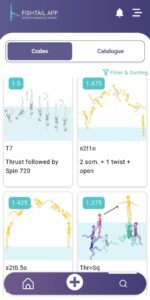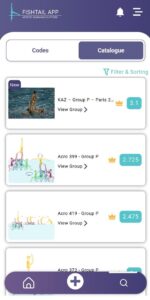Fishtail App is a new tool built for the artistic swimming community, helping coaches, choreographers, and technical controllers navigate the latest rules with ease and simplifying the routine-creation process.
Created by Laila Badawi, the mobile app offers a digital catalogue to help create codes for hybrids and acrobatics, and lets users build routines, calculate Degrees of Difficulty (DD), and even receive feedback from technical controllers.
Based in Cairo, Egypt, Badawi doesn’t come from an artistic swimming background herself, but two of her three daughters compete at the club level. When she first came across the new rule changes, it was her introduction to artistic swimming altogether; she admits she still has no idea how the sport actually works underwater.
The idea for Fishtail App came to her in 2023 when she noticed coaches juggling resources in an effort to understand the changes to the rules, specifically the introduction of the declared difficulty.

“I was at the pool for a long time, watching. I was interested to know what they were doing and how the girls would be scored when competition time came,” she said. “ But I saw the coaches calculating things, taking videos, sending messages to other people, and printing out a lot of PDFs. They were just kind of confused about the whole thing, but when I read the World Aquatics Competition Regulations, I felt that it could be very logically done by using technology.”
Badawi has a Bachelor of Engineering in Architecture and a Master of Science in Architectural and Building Sciences/Technology from Cairo University. That extensive, academic background provided her with much of the knowledge she needed to create Fishtail.
She was already comfortable using technology in her architectural work, where digital tools help teams share files and speak the same “language.” Applying that same mindset, she saw an opportunity to build something similar for artistic swimming, and to provide a practical, tech-based solution to help the community collaborate more easily.
Overall, Badawi aims to make working with the new rules easier and more accessible to athletes, coaches, and officials around the world. And save some time during training.
“I’m just hoping that the Fishtail App helps people focus on the execution part, not on the calculator part,” she said. “It shouldn’t be that, just because you have elite coaches and technical experts, you can play the sport. It’s not fair to lose just because you put something wrong on the Coach Card. Fishtail is kind of democratizing the whole process.”
Many people contributed to the first edition of Fishtail, which was rolled out in November 2023, by providing feedback on early versions of the app — among them were local coaches in Egypt, as well as Puerto Rican Olympian Leilani Torres. Badawi had also brought a prototype of Fishtail to the 2023 World Cup in Soma Bay, where she received feedback from coaches from across the world.
Badawi also pointed to Ana Montero, the current Technical Director of Artistic Swimming at the Royal Spanish Swimming Federation and a member of World Aquatics’ Technical Committee, as someone who offered valuable feedback and encouragement in Fishtail App’s early stages. Montero has remained a strong supporter of Badawi’s work on the app ever since.
Fishtail App’s name was inspired by the new rules and illustrates Badawi’s goal of increasing accessibility.
“When I was reading the rule book for the first time, I noticed the fishtail position, and it was written that it was previously known as crane,” she explained. “It reflected that the new rules have a new application — fishtail is a new name for an old position. And, I really like the position itself because if you see the diagram from 2022, it had three different positions and they’re all fishtails. It felt inclusive of all skills: you can do fishtail with a small angle or a right angle or a big angle — you don’t have to be an expert to do it.”
Fishtail was originally released as a visual reference for hybrids and acrobatics. A user could input different codes, and the app would show images to provide examples of what the codes looked like. The first version of the app came together quickly — Badawi built it in just a week. Since then, the app has continued to evolve, with updates every month or two that focus on improving usability and making the verification process more accurate.
All of the information available on Fishtail comes directly from official sources like the World Aquatics Artistic Swimming Competition Regulations and reference sheets. Badawi is careful to include only verified material, always pulling from reliable documents rather than personal interpretation. She’s the first to say she’s not an expert, just someone making sure everything in the app is backed by a clear source.
Currently, some of Fishtail’s main functionalities include the Search and Learn tool, the Acro and Hybrid Builder, and the Share and Consult tool.
With the Search and Learn tool, users can filter hybrid codes by family (T, S, R, A, F, C) and event (solo, duet, team) or look them up by name. The app then provides a description and a visual example. The process for finding acro codes is similar — users can search for a specific code or filter by group (A, B, C, P) and ‘sequence family’ (for example, construction, direction, or grip/connection, among others).
This library of codes is free to use, but premium users have additional access to more examples as well as further in-depth information regarding definitions, allowances, etc. taken directly from the World Aquatics Artistic Swimming Competition Regulations.
“People can read about all the different techniques, the execution tips, how to avoid the base mark, all this,” Badawi said. “This is just one of several additional features users gain access to with a premium subscription.”

The Acro and Hybrid Builder allows users to create shareable files for acrobatics and hybrids. For the latter, users can import up to three optional reference videos and then build the hybrid using codes from the library. Fishtail App will automatically calculate the DD in real time, taking into account the starting basemark value as well as any inputted factoring and pattern change bonuses.
The software also ensures that a hybrid’s code does not exceed the limits of three declarations per code and five declarations per family. After creating a hybrid in the app, a user can then copy a properly-formatted version of the hybrid code, view it as an ‘element file’ with notes in the app, or export it as a PDF. The process for creating an acrobatic file is similar.
The Share and Consult feature enables a user to share Fishtail files over e-mail, and choose between adding others on as viewers or editors.“Right now, a lot of coaches share files with their athletes to send them the different hybrids and to have the hybrids visually available,” Badawi said.
The additional ‘Share With Technical Controller’ option gives users the option to submit their code and an accompanying video to Fishtail’s network of technical controllers for feedback. Generally, Fishtail aims to process questions within 48 hours and gather opinions from three different certified technical controllers from three different countries.
While Badawi began building Fishtail on her own, she now works with a partner, Amro Khorshid, who has a computer science background. His expertise has helped the app grow quickly, allowing the development team to roll out new features more efficiently than Badawi could have managed on her own.
Fishtail App is continuously being updated, with upcoming features like video tutorials and a ‘routine builder’ that can generate a full coach card. Whenever she gets a chance, Badawi regularly talks with people within the community, and reads messages from users on social media or via e-mail, using their feedback to guide future updates.
Looking ahead, she hopes to integrate AI that can recognize codes directly from video footage. “My full vision has always been to just take your phone, take a video, and have the app tell you what code it was. Hopefully, one day, it will be like I first imagined it.”
Fishtail’s growth has been entirely organic, driven by word of mouth within the artistic swimming community. Badawi takes pride in how the app has spread naturally, without any marketing budget and only thanks to people sharing it with others.

Fishtail App has been downloaded in more than 50 countries around the globe, the top five being the U.S., Italy, France, Canada, and Spain. Going forward, Badawi hopes to expand the user base, which currently stands at about 3,700.
“Up until now, the Fishtail App was very focused on the coaches, but we want everyone involved,” she said. “We want the athletes to come and look at the pictures, we want the parents to come and look at the videos, we want the judges to share their knowledge as well.”
Despite never being an artistic swimmer herself, Badawi’s love for the sport drives her commitment to improving Fishtail App and supporting the artistic swimming community.
“I’ve met so many wonderful people, and this is something I enjoy a lot,” she added. “Talking to people from different cultures just shows me how we can all connect through the love of this sport and put our passion into it. I’m very happy that I’m making a positive impact, and it is something very meaningful to me.”
Article by Marikit Flores
Cover photo: World Aquatics
If you’ve enjoyed our coverage, please consider donating to Inside Synchro! Any amount helps us run the site and travel costs to cover meets during the season.



